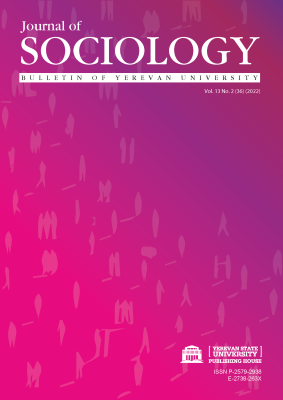Gender Inequality and Poverty in Armenia: A Multidimensional Approach
DOI:
https://doi.org/10.46991/BYSU:F/2022.13.2.038Keywords:
poverty, gender, multidimensional poverty, unpaid domestic work, gender pay gap, feminization of povertyAbstract
A gender perspective highlights that poverty affects women and girls disproportionally due to gender biases, unequal division of power in society and social expectations from the roles of men and women. Starting from the 1980s, feminist researchers had begun to raise the issue of the feminization of poverty, and stressed the importance of the intersectionality between not only poverty and gender, but also poverty, gender, ethnicity, age, marital status, etc.
Multidimensional analyses of poverty can become the most appropriate methodological approach to understand interconnections between gender and poverty. In order to reveal the whole spectrum of impacts of poverty on different social groups, a multidimensional analysis focuses on 1) opportunities and choices; 2) resources; 3) power and voice; 4) human security. In the article, poverty among men and women in Armenia is presented and recommendations to mitigate poverty among various women's groups are presented.
References
A Briefer: Gender Inequality Causes Poverty (2021). USAID, available at: https://banyanglobal.com/wp-content/uploads/2021/03/Gender-Inequality-Causes-Poverty-Briefer.pdf
Armenia Country Gender Assessment (2019). Asian Development Bank, available at: https://www.adb.org/sites/default/files/institutional-document/546716/armenia-country-gender-assessment-2019.pdf
Philips, A. (1998). Feminism and Politics. Oxford University Press, Oxford-New York.
Baseline Study on Gender Norms and Stereotypes in the Countries of the Eastern Partnership (2022). UN Women
Cagatay, N. (1998). Gender and Poverty. Social Development and Poverty Elimination Division, UNDP, available at: https://www.undp.org/sites/g/files/zskgke326/files/publications/GenderandPoverty.pdf
Congrave, J. and Gomtsyan, A. (2020). The Armenia Good Governance Fund and Gender Equality, UKAID WOW Helpdesk, London, available at: https://assets.publishing.service.gov.uk/government/uploads/system/uploads/attachment_data/
file/895766/Query-45-Armenia-Good-Governance-Fund2.pdf
Country Gender Profile Armenia (2021), European Union, available at: https://www.eeas.europa.eu/sites/default/files/documents/Country%20Gender%20Profile_%20ARMENIA_ENG.pdf
Gender and Poverty: A Case of Entwined Inequalities, Social Watch: Poverty Eradication and Gender Justice, available at: https://www.socialwatch.org/node/11590
Global Multidimensional Poverty Analyses (2020), Swedish International Development Agency, available at: https://cdn.sida.se/app/uploads/2021/09/27093243/10205251_Sida_multidimensional_poverty_webb.pdf
Hartmann, H. I. (2012). Women, Work and Poverty: Women Centered Research for Policy Change. Routledge, New York, London.
Hochschild, A.R. (2012). The Managed Heart. University of California Press, Berkeley and Los Angeles, California.
Honorati, M., et al. (2019). Work for a Better Future in Armenia: An Analysis of Jobs Dynamics. Yerevan: World Bank, available at: https://documents1.worldbank.org/curated/en/387401564380250230/pdf/Work-for-a-Better-Future-in-Armenia-An-Analysis-of-Jobs-Dynamics.pdf
Shahnazaryan, G., Aznauryan, Z., Saghumyan, L. (2016). Representation and Participation of Women in the Political Parties and Political Initatives in Armenia: Gender Analyses. Yerevan: Women's Resource Center.
Silenced Voices: Femicide in Armenia 2016-2017 (2019). Coalition to Stop Violence against Violence, available at: http://coalitionagainstviolence.org/hy/publication/femicide2018/
Spencer-Wood, S. M. (2011). Commentary: How Feminist Theory Increases Our Understanding of the Archaeology of Poverty. Historical Archaeology, 45(3), 183–193.
The Invisible Side of Everyday Life: Gender Stereotypes in Daily Routine (2018). AM Partners Consulting Company, World Vision Armenia. Yerevan, Asoghik
The Female Face of Poverty (2018). Women’s Budget Group, available at: https://wbg.org.uk/wp-content/uploads/2018/08/FINAL-Female-Face-of-Poverty.pdf
Understanding Poverty from a Gender Perspective (2004). Women and Development Unit, UNDP, available at: https://repositorio.cepal.org/bitstream/handle/11362/5926/1/S046466_en.pdf
United Nations Entity for Gender Equality and the Empowerment of Women and Statistical Committee of the Republic of Armenia (2020). Analysis of the gender pay gap and gender inequality in the labor market in Armenia, UN Women, Yerevan, available at: https://www.armstat.am/file/article/analysis_of_the_gender_pay_gap_armenia_en.pdf
Walby, S. (1989). Theorizing Patriarchy. Sociology, 2 (2), 213-234, available at: https://www.jstor.org/stable/42853921?seq=8#metadata_info_tab_contents
World Survey on the Role of Women in Development. Why Addressing Women’s Income and Time Poverty Matters for Sustainable Development (2020). UN Women, available at: https://www.socialwatch.org/node/11590-
Women and Men in Armenia. The Statistical Committee of the Republic of Armenia (2020). available at: https://armstat.am/file/article/gender_2020.pdf
Women’s Economic Inactivity and Engagement in the Informal Sector in Armenia (2018). UN Women, Tbilisi, available at: https://georgia.unwomen.org/en/digital-library/publications/2018/12/womens-economic-inactivity-and-engagement-in-the-informal-sector-in-armenia
Downloads
Published
How to Cite
Issue
Section
License
Copyright (c) 2022 Gohar Shahnazaryan

This work is licensed under a Creative Commons Attribution-NonCommercial 4.0 International License.








